Android robots spy, race, and mix cocktails
Nov 23, 2011 — by Eric Brown — from the LinuxDevices Archive — 4 viewsA startup called Romotive is readying a small, tank-tread “Romo” robot controlled by Android and iPhone smartphones that communicate to the robot via audio signals. Meanwhile, a prototype bartending robot called the iZac — based on a Motorola Xoom tablet and Arduino Mega controller board — has been created by developer Nick Johnson via the Android Open Accessory Development Kit.
Romotive, a startup run by Peter Seid and Phu Nguyen, has raised over $114,000 from more than 1,100 contributors looking to buy the company's first-generation Romo robots. The company, which launched the project on the KickStarter website, can now move forward on production of the motorized treadwheel robot — controlled by an attached Android smartphone, iPhone, or iPod Touch.
The Romo robots start at just $78, a price kept low by the fact that most of the robot's capabilities are already provided by a customer's own smartphone. One phone plugs into the top of the device, acting as its face, eyes, and ears, while another can connect via Wi-Fi as a remote control device.
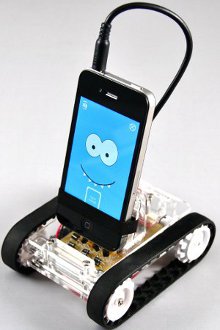
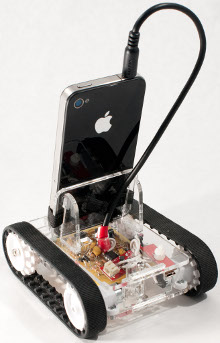
Two views of the Romo with iPhone
(Click on either to enlarge)
Romotive plans to release full detail on the design under open source license, and develop new hardware modules. Third-party developers are invited to do the same as long as they contribute their designs back to the Romotive community.
An app store is planned to sell apps for the Romo, but initially apps will be downloadable though iTunes and the Android Market. The robot currently offers a RomoRemote spy robot app that controls the smartphone camera, and can send audio "shout-outs." Also available is a Romo Kart multi-user racing game that includes the ability to send digital attacks, such as disabling an opponent's power, and deflecting incoming digital "bombs," says Romotive.
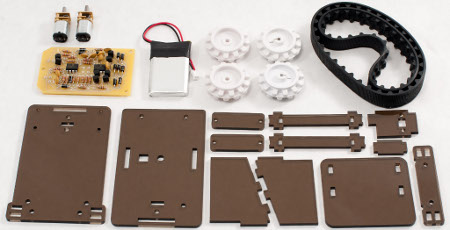
Romo components
(Click to enlarge)
No ship date has been announced, but in the meantime, more information may be found in the Kickstarter blog announcement, as well as the Romotive website and Romotive forum page.
iZac, the Android bartender
Because even robot enthusiasts can get thirsty tinkering with their devices, developer Nick Johnson created a open source, prototype bartending robot. His iZac "barbot" proof of concept uses a Motorola Xoom Android tablet to control an Arduino Mega controller board.
Google's Android Open Accessory Development Kit, which debuted on Android 3.1, handles communications between the Xoom tablet and the Arduino controller via a USB host connection.
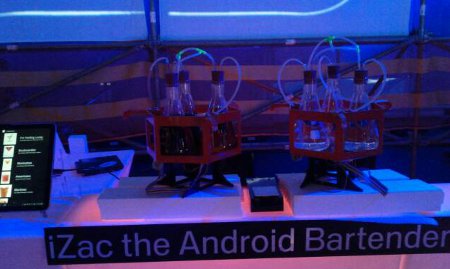
iZac being demonstrated at Google Developer Days, with Xoom at left
(Click to enlarge)

Closer view of iZac in action
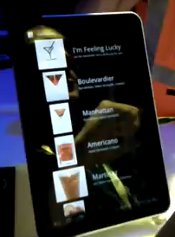 For the outlet, however, Johnson used a different approach, creating his own laser cut pinch valve design to suction out the proper amounts of liquid based on the difference in air pressure. This design was chosen because it does not require interrupting the tubing, thereby making it "perfectly foodsafe," according to Johnson.
For the outlet, however, Johnson used a different approach, creating his own laser cut pinch valve design to suction out the proper amounts of liquid based on the difference in air pressure. This design was chosen because it does not require interrupting the tubing, thereby making it "perfectly foodsafe," according to Johnson.
The tubing system is controlled by a digital scale that continually weighs the glass. The scale sits between two three-bottle turntables, with one spout attached per bottle. The turntable rotates to present the appropriate spout above the glass before dispensing the liquid.
Johnson designed his own Arduino shield — a small extension board — for the Arduino Mega controller module. The shield, shown below, includes an INA125 instrumentation amplifier, an LM317 voltage regulator, and dual 2n7000 MOSFETs that switch the pump for each turntable on and off.
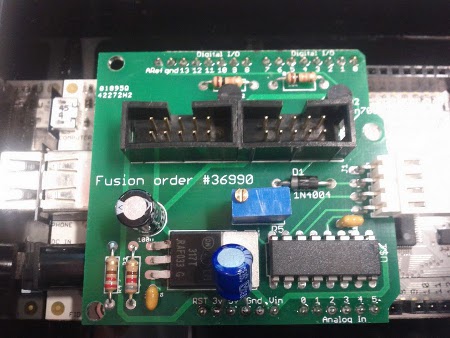
The iZac's custom Arduino Mega shield
(Click to enlarge)
Johnson notes other flaws in the design that could be fixed in future versions. Johnson's blog offers many more details on the iZac design. The blog also offers links to the design code and schematics available for free download under open source licensing.
iZac demo'd at the GDD Creative Sandbox event on YouTube
Source: Nick Johnson
(Click to play)
Another iZac demo onYouTube
Source: Nick Johnson
(Click to play)
This article was originally published on LinuxDevices.com and has been donated to the open source community by QuinStreet Inc. Please visit LinuxToday.com for up-to-date news and articles about Linux and open source.